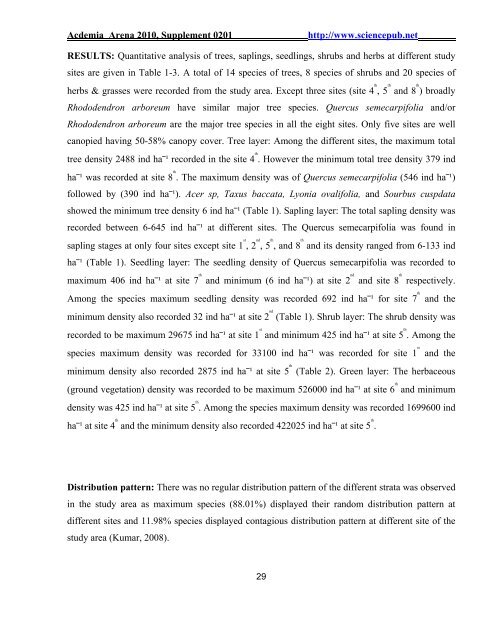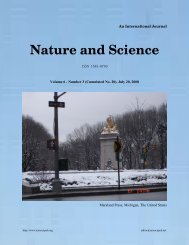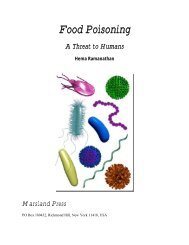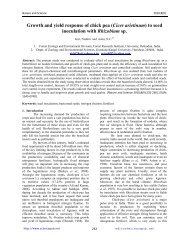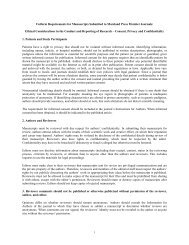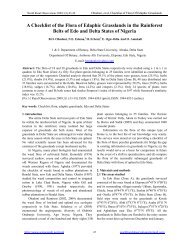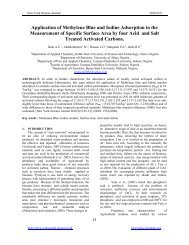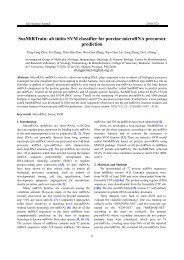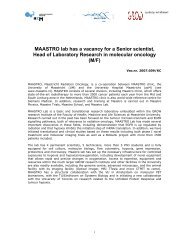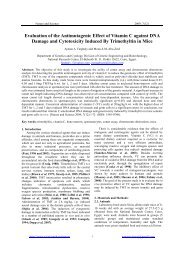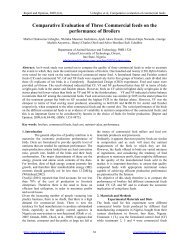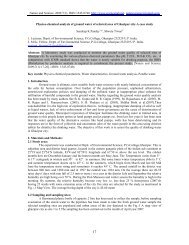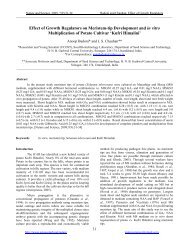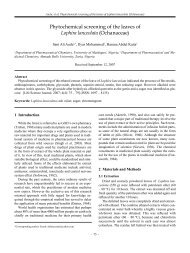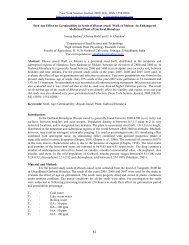Ecological, Social and Commercial Role of Lichens in India with ...
Ecological, Social and Commercial Role of Lichens in India with ...
Ecological, Social and Commercial Role of Lichens in India with ...
You also want an ePaper? Increase the reach of your titles
YUMPU automatically turns print PDFs into web optimized ePapers that Google loves.
Acdemia Arena 2010, Supplement 0201<br />
http://www.sciencepub.net<br />
RESULTS: Quantitative analysis <strong>of</strong> trees, sapl<strong>in</strong>gs, seedl<strong>in</strong>gs, shrubs <strong>and</strong> herbs at different study<br />
sites are given <strong>in</strong> Table 1-3. A total <strong>of</strong> 14 species <strong>of</strong> trees, 8 species <strong>of</strong> shrubs <strong>and</strong> 20 species <strong>of</strong><br />
herbs & grasses were recorded from the study area. Except three sites (site 4 th , 5 th<br />
<strong>and</strong> 8 th ) broadly<br />
Rhododendron arboreum have similar major tree species. Quercus semecarpifolia <strong>and</strong>/or<br />
Rhododendron arboreum are the major tree species <strong>in</strong> all the eight sites. Only five sites are well<br />
canopied hav<strong>in</strong>g 50-58% canopy cover. Tree layer: Among the different sites, the maximum total<br />
tree density 2488 <strong>in</strong>d ha⎯¹ recorded <strong>in</strong> the site 4 th . However the m<strong>in</strong>imum total tree density 379 <strong>in</strong>d<br />
ha⎯¹ was recorded at site 8 th . The maximum density was <strong>of</strong> Quercus semecarpifolia (546 <strong>in</strong>d ha⎯¹)<br />
followed by (390 <strong>in</strong>d ha⎯¹). Acer sp, Taxus baccata, Lyonia ovalifolia, <strong>and</strong> Sourbus cuspdata<br />
showed the m<strong>in</strong>imum tree density 6 <strong>in</strong>d ha⎯¹ (Table 1). Sapl<strong>in</strong>g layer: The total sapl<strong>in</strong>g density was<br />
recorded between 6-645 <strong>in</strong>d ha⎯¹ at different sites. The Quercus semecarpifolia was found <strong>in</strong><br />
sapl<strong>in</strong>g stages at only four sites except site 1 st , 2 nd , 5 th , <strong>and</strong> 8 th <strong>and</strong> its density ranged from 6-133 <strong>in</strong>d<br />
ha⎯¹ (Table 1). Seedl<strong>in</strong>g layer: The seedl<strong>in</strong>g density <strong>of</strong> Quercus semecarpifolia was recorded to<br />
maximum 406 <strong>in</strong>d ha⎯¹ at site 7 th <strong>and</strong> m<strong>in</strong>imum (6 <strong>in</strong>d ha⎯¹) at site 2 nd <strong>and</strong> site 8 th respectively.<br />
Among the species maximum seedl<strong>in</strong>g density was recorded 692 <strong>in</strong>d ha⎯¹ for site 7 th<br />
<strong>and</strong> the<br />
m<strong>in</strong>imum density also recorded 32 <strong>in</strong>d ha⎯¹ at site 2 nd (Table 1). Shrub layer: The shrub density was<br />
recorded to be maximum 29675 <strong>in</strong>d ha⎯¹ at site 1 st <strong>and</strong> m<strong>in</strong>imum 425 <strong>in</strong>d ha⎯¹ at site 5 th . Among the<br />
species maximum density was recorded for 33100 <strong>in</strong>d ha⎯¹ was recorded for site 1 st<br />
<strong>and</strong> the<br />
m<strong>in</strong>imum density also recorded 2875 <strong>in</strong>d ha⎯¹ at site 5 th<br />
(Table 2). Green layer: The herbaceous<br />
(ground vegetation) density was recorded to be maximum 526000 <strong>in</strong>d ha⎯¹ at site 6 th <strong>and</strong> m<strong>in</strong>imum<br />
density was 425 <strong>in</strong>d ha⎯¹ at site 5 th . Among the species maximum density was recorded 1699600 <strong>in</strong>d<br />
ha⎯¹ at site 4 th <strong>and</strong> the m<strong>in</strong>imum density also recorded 422025 <strong>in</strong>d ha⎯¹ at site 5 th .<br />
Distribution pattern: There was no regular distribution pattern <strong>of</strong> the different strata was observed<br />
<strong>in</strong> the study area as maximum species (88.01%) displayed their r<strong>and</strong>om distribution pattern at<br />
different sites <strong>and</strong> 11.98% species displayed contagious distribution pattern at different site <strong>of</strong> the<br />
study area (Kumar, 2008).<br />
29


